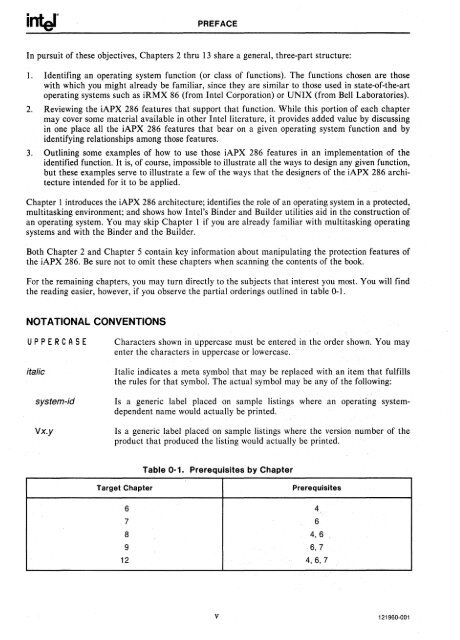iAPX 286 Operating System Writers Guide 1983
iAPX 286 Operating System Writers Guide 1983
iAPX 286 Operating System Writers Guide 1983
Create successful ePaper yourself
Turn your PDF publications into a flip-book with our unique Google optimized e-Paper software.
PREFACEIn pursuit of these objectives, Chapters 2 thru 13 share a general, three-part structure:1. Identifing an operating system function (or class of functions). The functions chosen are thosewith which you might already be familiar, since they are similar to those used in state-of-the-artoperating systems such as iRMX 86 (from Intel Corporation) or UNIX (from Bell Laboratories).2. Reviewing the <strong>iAPX</strong> <strong>286</strong> features that support that function. While this portion of each chaptermay cover some material available in other Intel literature, it provides added value by discussingin one place all the <strong>iAPX</strong> <strong>286</strong> features that bear on a given operating system function and byidentifying relationships among those features.3. Outlining some examples of how to use those <strong>iAPX</strong> <strong>286</strong> features in an implementation of theidentified function. It is, of course, impossible to illustrate all the ways to design any given function,but these examples serve to illustrate a few of the ways that the designers of the <strong>iAPX</strong> <strong>286</strong> architectureintended for it to be applied.Chapter 1 introduces the <strong>iAPX</strong> <strong>286</strong> architecture; identifies the role of an operating system in a protected,multitasking environment; and shows how Intel's Binder and Builder utilities aid in the construction ofan operating system. You may skip Chapter 1 if you are already familiar with multitasking operatingsystems and with the Binder and the Builder.Both Chapter 2 and Chapter 5 contain key information about manipulating the protection features ofthe <strong>iAPX</strong> <strong>286</strong>. Be sure not to omit these chapters when scanning the contents of the book.For the remaining chapters, you may turn directly to the subjects that interest you most. You will findthe reading easier, however, if you observe the partial orderings outlined in table 0-1.NOTATIONAL CONVENTIONSUPPERCASEitalicsystem-idvx.yCharacters shown in uppercase must be entered in the order shown. You mayenter the characters in uppercase or lowercase.Italic indicates a meta symbol that may be replaced with an item that fulfillsthe rules for that symbol. The actual symbol may be any of the following:Is a generic label placed on sample listings where an operating systemdependentname would actually be printed.Is a generic label placed on sample listings where the version number of theproduct that produced the listing would actually be printed.Table 0-1. Prerequisites by ChapterTarget ChapterPrerequisites6 47 68 4,69 6,712 4, 6, 7v 121960-001
















